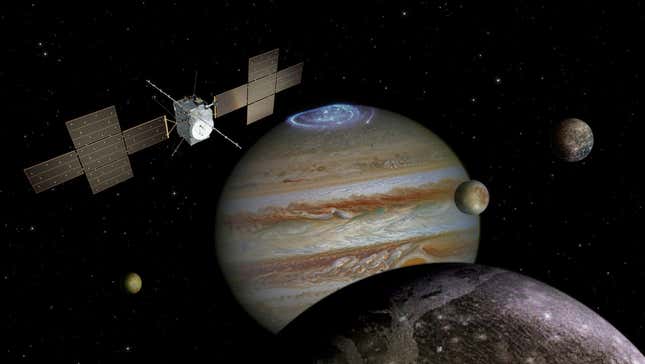
More than a decade after the mission was announced, JUICE is finally ready for its much-anticipated journey to Jupiter. Packed with 10 instruments, it’s one of the most advanced probes ever sent to the outer solar system. Here’s your guide to the European Space Agency’s historic mission, set to launch on April 13.
NASA’s Juno spacecraft has been exploring Jupiter for the past seven years, but the mission is set to expire in 2025. The space agency’s Lucy probe is currently en route to Jupiter’s orbit, but it won’t investigate the gas giant and will instead focus on the Trojan asteroids. As a result, there’s going to be a gap when it comes to our on-the-scene investigations of Jupiter and its intriguing moons, but NASA’s Europa Clipper and ESA’s JUICE will soon be on their way, the latter probe launching next week.
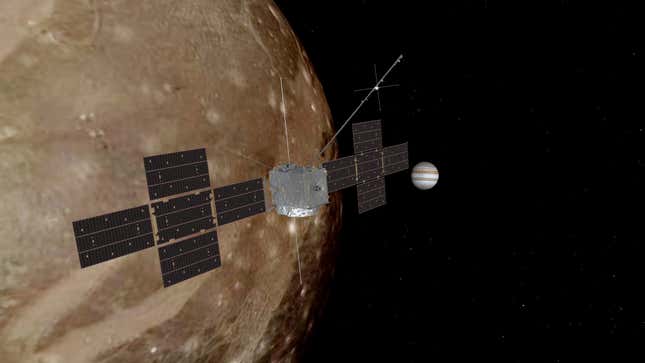
JUICE, short for JUpiter ICy moons Explorer, is headed for Jupiter, but the spacecraft will focus its observations on three of the gas giant’s many moons: Europa, Ganymede, and Callisto. Jupiter, the largest planet in the solar system, hosts more than 70 natural satellites, but these three Galilean moons are thought to hold immense amounts of subsurface water hidden beneath thick layers of ice (Io is the fourth Galilean moon, but it’s an inhospitable volcanic hellhole). JUICE, an international collaboration headed by the European Space Agency, will spend three to four years at Jupiter, performing flybys and making detailed observations of the three icy moons and their immediate surroundings.
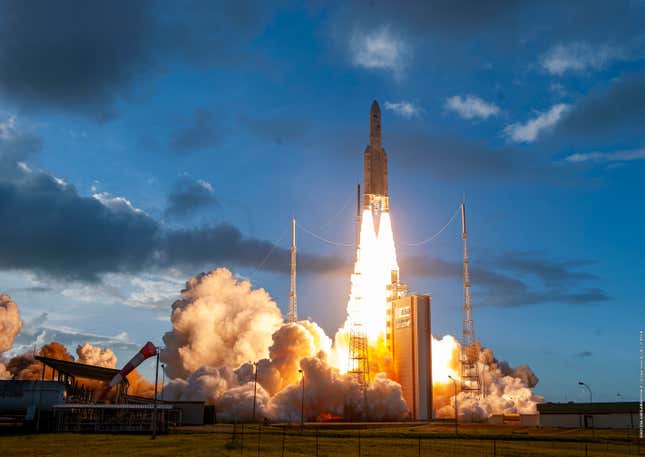
An Arianespace Ariane 5 rocket has been entrusted with launching the $1.6 billion probe. Blastoff is set for 8:15 a.m. ET on April 13 from Europe’s Spaceport in French Guiana. The mission, known as VA260, will be Arianespace’s 30th scientific mission and the 116th launch of Ariane 5 overall, according to the company. JUICE will be Europe’s first mission to the Jovian system. Once freed from the rocket’s payload fairing and Earth’s gravitational field, the 6-metric-ton JUICE will race away at speeds reaching 1.6 miles per second (2.5 kilometers per second).
JUICE will reach Jupiter in 2031 following an eight-year journey, but to get there it’ll need to receive four gravity boosts from Earth and Venus. Excitingly, the spacecraft’s flyby of the Earth-Moon system, a maneuver known as a Lunar-Earth gravity assist (LEGA), has never been attempted before. As ESA explains, JUICE will first get a gravitational assist from the Moon and then a second from Earth some 1.5 days later, in a maneuver meant to “save a significant amount of propellant.”

Europa, Ganymede, and Callisto are all suspected of containing subsurface oceans capped in an icy crust. JUICE will evaluate the trio for potential signs of habitability, given the assumed presence of liquid water. Indeed, and as ESA makes clear, the overarching question of the mission is whether gas giants can harbor habitable conditions and spawn primitive life. In addition to its astrobiological duties, JUICE will seek to answer questions about planetary formation and the solar system in general. More conceptually, the spacecraft will evaluate the “wider Jupiter system as an archetype for gas giants across the Universe,” according to ESA.
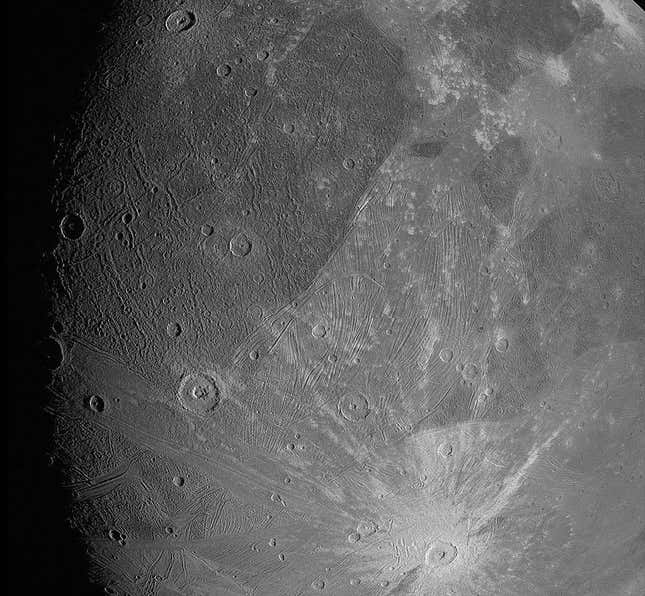
JUICE is scheduled to perform 35 Jovian moon flybys, but the mission will end with the spacecraft settling into a circular orbit around Ganymede, where it will work for an estimated six months and come as close as 311 miles (500 km) to its surface. By doing so, “Juice will be the first spacecraft to ever orbit a moon in the outer Solar System,” ESA claims. The space agency chose a good target, as Ganymede, the biggest moon in the solar system, is the only known moon to exhibit its own magnetic field, which causes it to interact with the Jovian environment in unique ways.
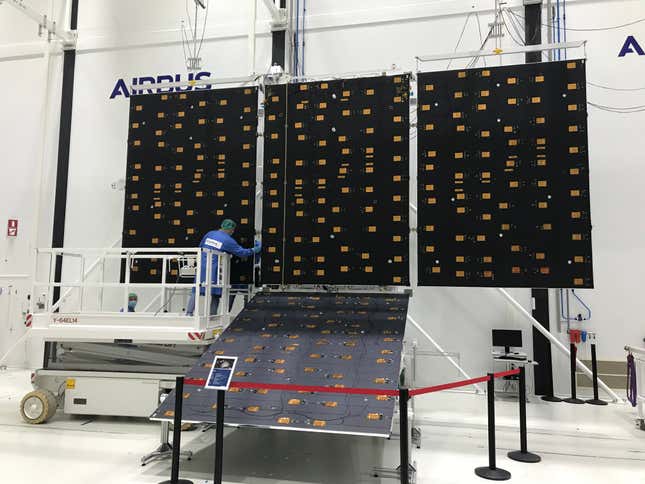
ESA approved the JUICE mission in 2012 as part of its Cosmic Vision science program. Airbus Defence and Space built the probe, which features an 8.2-foot-long (2.5-meter) high gain antenna and 10 solar panels. When unfurled, the solar panels will total 915 square feet (85 square meters) in size, making it the largest array to ever be deployed for an interplanetary mission, according to ESA. The panels, even when so far from the Sun, will power the probe and its instruments with 850 Watts of power.
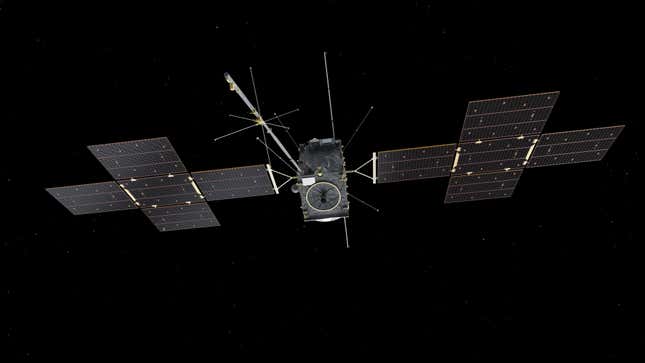
The 10 carbon fiber-reinforced honeycomb panels will unfold once JUICE gets to space, and when they do, they’ll create two cross-like shapes, one on each side of the probe. The two solar arrays will deploy some 50 minutes after launch, in a process that should take about one minute. The medium-gain antenna, which will emerge 16 hours into the mission, will be used during the flybys of the moons and also link the probe to controllers on Earth when the spacecraft’s larger antenna is being leveraged as a sunshield.
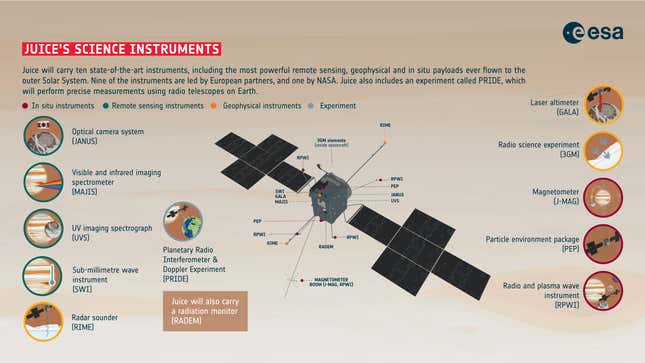
The 10 instruments coming along for the ride comprise the “most powerful remote sensing, geophysical and in situ [sensors for gathering data in JUICE’s immediate environment] payload complement ever flown to the outer Solar System,” ESA claims. Both NASA and Japan’s space agency contributed to this diverse suite of tools. Specific capabilities include optical and spectral imaging, sensors for exploring the moons’ surface and subsurface features, and instruments for measuring magnetic fields and radio and plasma waves.
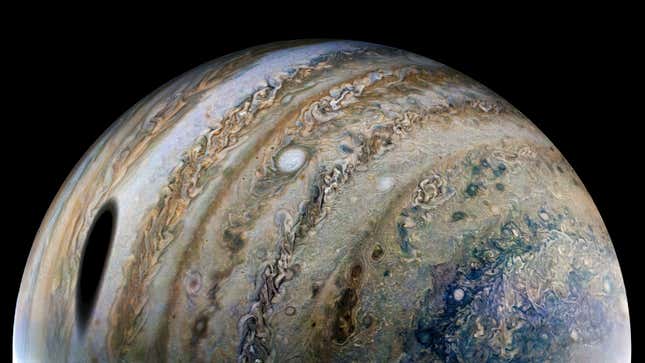
“Juice’s cameras will capture exquisite details of the moon’s features, as well as identify the ices and minerals on their surfaces,” writes ESA in its press kit. “Other instruments will sound the subsurface and interior of the moons to better understand the location and nature of their buried oceans. The tenuous atmosphere around the moons will also be explored.”
JUICE is also traveling with a science experiment that leverages the probe’s communication system with ground-based telescopes on Earth, which will help controllers to determine the spacecraft’s position and velocity.

Italian astronomer Galileo Galilei was the first scientist to view Jupiter and its four largest moons through a telescope, which he did in 1610. In honor of the famed astronomer, ESA has prepared a commemorative plaque featuring imagery of Galilei’s first observations of Jupiter, as recorded in his Sidereus Nuncius manuscript (see below).

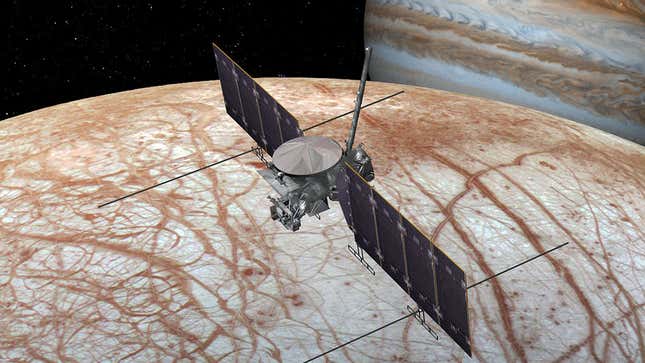
Jupiter is very hot right now, as JUICE is one of three planned missions to the gas giant, including Lucy. NASA’s Europa Clipper is set to launch in October 2024, but as NASA program scientist Curt Niebur explained in a statement in 2017, the two missions will complement each other. “The missions are like close members of the same family. Together they will explore the entire Jovian system,” he explained. “Clipper is focused on Europa and determining its habitability. JUICE is looking for a broader understanding how the entire group of Galilean satellites formed and evolved.” Europa Clipper is expected to arrive at Jupiter in April 2030.
For more spaceflight in your life, follow us on Twitter and bookmark Gizmodo’s dedicated Spaceflight page.
"juice" - Google News
April 05, 2023 at 09:43PM
https://ift.tt/ZNsVdqK
What to Know About the JUICE Mission to Jupiter and Its Frozen Moons - Gizmodo
"juice" - Google News
https://ift.tt/zUFY6c4
https://ift.tt/ELJtocm
Bagikan Berita Ini















0 Response to "What to Know About the JUICE Mission to Jupiter and Its Frozen Moons - Gizmodo"
Post a Comment